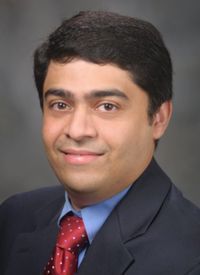Will Slow and Steady Progress in Treating SCLC Win the Race?
Clinical advances in treatment of small cell lung cancer have lagged behind those of other tumor types, but the delay is not for lack of effort.
Stephen V. Liu, MD

Clinical advances in the treatment of small cell lung cancer (SCLC) have lagged behind those of other tumor types, but the delay is not for lack of effort. In recent years, however, improved understanding of disease biology has identified some novel targets that may make these tumors more vulnerable to treatment. One such approach in the frontline setting has been the integration of various immune checkpoint inhibitors into chemotherapy regimens, whereas in the second-line setting, a new chemotherapy agent has recently been added to the treatment armamentarium.
During a recent OncLive Peer Exchange®, a panel of thoracic cancer experts discussed the latest developments in treating patients with SCLC in both the first- and second-line settings. They examined the clinical trial data for some newer agents, including some reassuring real-world data, and discussed how they use these agents in clinical practice.
Immune Checkpoint Inhibitors in the First Line
Two immune checkpoint inhibitors are FDA approved for use in combination with chemotherapy in treatment-naïve patients with extensive-stage SCLC: atezolizumab (Tecentriq) and durvalumab (Imfinzi).1,2 A third agent, pembrolizumab (Keytruda), was explored in the KEYNOTE-604 trial (NCT03066778) but did not meet the prespecified significance threshold for overall survival (OS).3
Atezolizumab
The FDA approved atezolizumab in March 2019 based on data from the phase 3 IMpower133 trial (NCT02763579).1 “IMpower133 was the first major change to frontline treatment for extensive-stage SCLC in 30 or 40 years.…[It] showed that adding the PD-L1 inhibitor atezolizumab concurrently with chemotherapy and as maintenance treatment to carboplatin-etoposide chemotherapy improved both progression-free survival [PFS] and OS with-out adding notable toxicity,” Stephen V. Liu, MD, said. He explained that although chemotherapy alone with platinum-etoposide provided reliably high response rates, it was also associated with high relapse rates and a short PFS and OS, spurring the search for better standards of care.
IMpower133 randomly assigned 403 treatment-naïve patients with extensive-stage SCLC to receive carboplatin and etoposide with either atezolizumab (n = 201) or placebo (n = 202).4 The combination showed benefit in OS and PFS after a median follow-up of 13.9 months, which was maintained with data from a median follow-up of 22.9 months (Table 1).4,5
Table 1. Follow-up Data From IMpower1334,5

“When we look at the curves, we see that they separate,” Liu said. “It’s not the degree of benefit we are all waiting for, but it’s clearly an improvement over chemotherapy alone. We are trying to identify the patients who derive benefit.” He noted that biomarker studies have thus far failed to show which patients are most likely to benefit from the addition of atezolizumab, with factors such as tumor mutational burden (TMB) and PD-L1 expression not found to be useful. Although Liu noted that patients with more inflammatory disease have shown enriched benefit with atezolizumab, this finding does not guide who should and should not receive this treatment.
Whereas biomarker studies have been somewhat disappointing, recent real-world data have been exciting. Liu discussed some real-world data for atezolizumab presented at the 2021 American Society of Clinical Oncology Annual Meeting.6 The data come from a retrospective review of The US Oncology Network electronic health records for adults with extensive-stage SCLC who received a diagnosis between October 2018 and December 2019, with follow-up through the end of March 2020. Of the 347 patients included in the study, 77% received atezolizumab. Liu said this shows a very broad uptake of the atezolizumab regimen in clinical practice. More importantly, despite the patients being much older and more diverse having more brain metastases compared with the IMpower133 population, outcomes were similar, with treatment duration, continued therapy, and marked survival being almost identical between the clinical trial and realworld cohorts, Liu explained.
“I love those real-world data because it’s a completely different patient population from what we get in clinical trials. We all realize that in the real world, that’s what we have, [so] it’s very comforting and good to see that the results seem to match what we got in the clinical trial in terms of the clinical efficacy,” Hossein Borghaei, DO, MS, said.
Hossein Borghaei, DO, MS

Durvalumab
The FDA approved durvalumab in March 2020 based on data from the phase 3 CASPIAN trial (NCT03043872).2 The CASPIAN trial included 805 treatment-naïve patients with extensive-stage SCLC who were randomly assigned 1:1:1 to durvalumab plus platinum-etoposide (n = 268), durvalumab plus tremelimumab plus platinum-etoposide (n = 268), or platinum-etoposide alone (n = 269).7 Interim analysis comparing results for durvalumab plus platinum-etoposide with platinum-etoposide alone showed significant benefit with the addition of durvalumab, with a median OS of 13.0 months (95% CI, 11.5-14.8) vs 10.3 months (95% CI, 9.3-11.2) in these treatment arms, respectively, (HR, 0.73; 95% CI, 0.590.91; P = .0047). At 18 months, 34% (95% CI, 26.9%-41.0%) of patients in the durvalumab arm were alive compared with 25% (95% CI, 18.4%31.6%) in the chemotherapy-alone arm. “It’s very similar to the atezolizumab data, which made everybody feel a little better,” Anne Chiang, MD, PhD, said.
Anne Chiang, MD, PhD

Chiang explained that although CASPIAN was similar in design to IMpower133, it had some distinguishing features. She noted that patients could be treated with cisplatin or carboplatin per investigator’s choice and that the trial included patients with asymptomatic brain metastases, including those previously treated with prophylactic cranial irradiation. The trial also included a third arm, which added the anti–CTLA-4 monoclonal antibody tremelimumab to durvalumab plus platinum-etoposide. She noted that the data for this arm were not positive, with a median follow-up of 25.1 months showing a median OS of a little over 10 months in both the tremelimumab and chemotherapy-alone arms.8
“Although there wasn’t a difference in OS [with the addition of tremelimumab], if you look at 12 months out at the landmark analysis, or even 24 months out, there are a significant number of patients surviving,” Chiang said, noting it is approximately 20% of all durvalumab-treated patients vs 5% of those treated with only chemotherapy. Furthermore, characterization of long-term clinical benefit in treatment responders suggests those who achieve a PFS of at least 12 months have exceptional 2-year OS rates greater than 75%, with patients receiving durvalumab more than 3 times as likely to derive long-term benefit.9 “That’s saying if you’re going to do well, you’re going to do really well,” Chiang said.
As with atezolizumab, TMB has not been found to be predictive of response to durvalumab treatment.9 “Whether or not you used a cut point of 10 or 16 mutations per megabase, that wasn’t predictive of response. TMB is not the marker here,” Chiang said.
Practical Perspectives on Chemotherapy-Immunotherapy
Wade T. Iams, MD

“For the most part, [I use] chemotherapy-immunotherapy for all patients,” Wade T. Iams, MD, said. He explained that a growing body of evidence suggests chemotherapy-immunotherapy can be safely used in most patients, including those previously thought to be ineligible, such as those with underlying autoimmune diseases, provided they are closely monitored for immune-related adverse effects (AEs). The only time he would not pursue this approach, Iams said, is in the setting of a severe underlying autoimmune disease with visceral organ damage requiring more than 10 mg of systemic glucocorticoids daily for maintenance. As for selecting between available checkpoint inhibitors, Iams said he “approach[es] atezolizumab and durvalumab as equivalent.”
When asked about the chemotherapy component of first-line SCLC treatment, Chiang said she usually uses carboplatin. “We’re talking about patients where we’re running a marathon. This is a disease that’s not curable. We want to provide our patients with the best quality of life they can achieve,” she said. Although she prefers carboplatin, she said she might consider cisplatin for young patients and those with good performance status.
Based on current data, the panelists agreed that adding an anti–CTLA-4 antibody does not have a role in treating SCLC. “When I look at the tail of the curve [in CASPIAN], the tail looks better in the durvalumab-tremelimumab arm and almost catches up to the durvalumab tail. I feel like that’s because of the durvalumab and that the only thing tremelimumab is adding there is cost and a heck of a lot of toxicity,” Liu explained.
Chiang agreed that although there does not appear to be a role for anti–CTLA-4 antibodies in treating the general population of patients with extensive-stage SCLC, she is working on an investigator-initiated trial that may help tease out whether an opportunity exists for these agents to provide benefit somewhere in the treatment course for certain subpopulations with SCLC. In the trial (NCT03670056), patients with relapsed SCLC, including those previously on atezolizumab maintenance, will receive ipilimumab (Yervoy)/nivolumab (Opdivo).10 “We’re doing pretreatment and on-treatment biopsies. There’s something to be said for looking at the tumor microenvironment and specifically the infiltration of T cells, so stay tuned for that. There may be a way anti–CTLA-4 may help juice up the microenvironment so that we get T cells in there so we can have a response,” she said.
Second-Line Treatments for SCLC
Once first-line treatment fails, patients with SCLC are left with few options. The National Comprehensive Cancer Network (NCCN) prefers that treatments for patients who relapse within 6 months include topotecan (Hycamtin) and lurbinectedin (Zepzelca), whereas rechallenge with first-line treatment is preferred for those who relapse after 6 months.11 The role of immune checkpoint inhibitors in the second-line setting remains unclear. Although single-agent nivolumab and pembrolizumab had been granted accelerated approval as treatment for patients with relapsed extensive-stage SCLC, this indication was voluntarily withdrawn by their manufacturers after these agents failed to show an OS benefit in confirmatory studies12,13 (Table 212-18).
Table 2. Efficacy Data for Withdrawn Immunotherapy Indications in SCLC12-18

Lurbinectedin
Lurbinectedin prevents transcription factors from binding to their recognition sequences, thereby inhibiting oncogenic transcription and leading to tumor cell apoptosis.14 The agent has also been shown to affect the tumor microenvironment by inhibiting activated transcription in tumor-associated macrophages.19 In June 2020, lurbinectedin received accelerated approval from the FDA for patients with metastatic SCLC with disease progression on or after platinum-based chemotherapy, making it the first drug approved by the FDA for this indication in more than 20 years.15 Approval was based on findings from a single-arm, open-label, phase 2 basket trial (NCT02454972) that included 105 patients with recurrent SCLC.20
“An overall response by investigator assessment was seen in 37 patients, for an [overall] response rate of 35.2% [95% CI, 26.2%-45.2%],” Vivek Subbiah, MD, said. The disease control rate was 68.6% (95% CI, 58.8%-77.3%), the median duration of response was 5.3 months (range, 4.1-6.4), the median PFS was 3.5 months (95% CI, 2.6-4.3), and the median OS was 9.3 months (95% CI, 6.3-11.8).19
Vivek Subbiah, MD

Lurbinectedin had a manageable safety profile, with the most common grade 3 to 4 AEs, irrespective of causality, being hematological abnormalities, particularly neutropenia (46%), leucopenia (29%), anemia (9%), and thrombocytopenia (7%).14 Serious treatment-related AEs occurred in 10% of patients, of which neutropenia and febrile neutropenia were the most common, with each affecting 5% of patients. No treatment-related deaths occurred.
Subbiah proceeded to discuss a study he presented at the European Society for Medical Oncology Virtual Congress 2020, in which investigators evaluated the activity of lurbinectedin in second-line patients with SCLC who were candidates for platinum rechallenge (ie, relapse after 6 months).21 “Interestingly, the investigator-assessed objective response rate in this cohort was 60%, with a median duration of 5.5 months and disease control rate of 95%. Of note, 60.9% and 27.1% of patients were alive at 1 and 2 years, respectively,” Subbiah said. Based on these findings, he noted that “lurbinectedin is an effective treatment for platinum-sensitive relapsed SCLC, especially in patients with a chemotherapy-free interval of greater than 180 days,” potentially making this option as viable as the NCCN’s preferred approach of rechallenge in these patients.
Putting Treatment Options Into Perspective
In patients who are candidates for rechallenge, Liu said he considers the length of benefit of the original treatment. “If there’s a long period of benefit, I revisit the platinum-etoposide and see whether I can kick lurbinectedin or topotecan as another option down the line. This is off trial, of course. We’re really pushing for trials in this subset,” he said, adding that when rechallenging with chemotherapy-immunotherapy, he maintains the checkpoint inhibitor in select patients, despite a lack of data to support this decision.
In contrast, Iams and Chiang said they do not continue the checkpoint inhibitor. Chiang said she goes back to the platinum-etoposide for 6 months. Although she acknowledged the lurbinectedin data are impressive, she is concerned that they are from a small study that did not include patients with brain metastases. “For patients whom we’ve been trying to keep out of the hospital, especially during this pandemic, I’ve been using some oral topotecan or potentially temozolomide if they have brain metastases,” she said. Taxanes are another good option for patients with brain metastases, Chiang said, adding that, anecdotally, she has seen some patients have a very good response to taxanes following checkpoint inhibitor therapy. “I don’t know whether there’s something that is boosted by adding chemotherapy post progression, as in the INSIGNA trial [NCT03793179]. Hopefully, we’ll learn something about that,” she said.
Although the FDA approvals of nivolumab and pembrolizumab were withdrawn, these agents remain options in the NCCN SCLC guidelines.11 “The NCCN small cell guidelines group ultimately voted to keep both of these drugs—although as a category 3—which indicates some discordance in the consensus,” Chiang said. She noted this discordance is not surprising because some patients have been found to do extremely well with a single-agent immune checkpoint inhibitor, even if the confirmatory trials did not show an OS benefit with these agents. Therefore, although nivolumab and pembrolizumab would now be used off label, she said they remain good options, especially for patients “who can’t tolerate chemotherapy or who have good performance status and can still be treated.”
Despite significant advances being made in SCLC, Subbiah noted that progress is approximately 15 years behind that of the non–small cell lung cancer field. “I’m sure there’s going to be a future renaissance of biomarkers and personalized therapy. Defining the subsets in SCLC represents the first step in our understanding of what drugs work best for which patient, at least preclinically. It at least gives us a guide for a path forward for personalized approaches,” he said. To help propel treatment forward, he encouraged physicians to enroll their patients with SCLC into clinical trials.
References
- FDA approves atezolizumab for extensive-stage small cell lung cancer. FDA. March 18, 2019. Updated March 19, 2019. Accessed September 9, 2021. bit.ly/2VE30ZU
- FDA approves durvalumab for extensive-stage small cell lung cancer. FDA. March 27, 2020. Updated March 30, 2020. Accessed September 9, 2021. bit.ly/38YFEkL
- Rudin CM, Awad MM, Navarro A, et al. Pembrolizumab or placebo plus etoposide and platinum as first-line therapy for extensive-stage small-cell lung cancer: randomized, double-blind, phase III KEYNOTE-604 study. J Clin Oncol. 2020;38(21):23692379. doi:10.1200/JCO.20.00793
- Horn L, Mansfield AS, Szczęsna A, et al; IMpower133 Study Group. First-line atezolizumab plus chemotherapy in extensive-stage small-cell lung cancer. N Engl J Med. 2018;379(23):2220-2229. doi:10.1056/NEJMoa1809064
- Liu SV, Reck M, Mansfield AS, et al. Updated overall survival and PD-L1 subgroup analysis of patients with extensive-stage small-cell lung cancer treated with atezolizumab, carboplatin, and etoposide (IMpower133). J Clin Oncol. 2021;39(6):619-630. doi:10.1200/JCO.20.01055
- Nadler ES, Vasudevan A, Davies K, Wang Y, Johnson A, Ogale S. Real-world evidence of cancer immunotherapy (CIT) combination treatment in first-line (1L) extensive-stage small cell lung cancer (ES-SCLC). J Clin Oncol. 2021;39(suppl 15):8561. doi:10.1200/ JCO.2021.39.15_suppl.8561
- Paz-Ares L, Dvorkin M, Chen Y, et al. Durvalumab plus platinum-etoposide versus platinum-etoposide in first-line treatment of extensive-stage small-cell lung cancer (CASPIAN): a randomised, controlled, open-label, phase 3 trial. Lancet. 2019;394(10212):1929-1939. doi:10.1016/S01406736(19)32222-6
- Goldman JW, Dvorkin M, Chen Y, et al. Durvalumab, with or without tremelimumab, plus platinum-etoposide versus platinum-etoposide alone in first-line treatment of extensive-stage small-cell lung cancer (CASPIAN): updated results from a randomised, controlled, open-label, phase 3 trial. Lancet Oncol. 2021;22(1):51-65. doi:10.1016/S1470-2045(20)30539-8
- Goldman JW, Garassino MC, Chen Y, et al. Durvalumab (D) ± tremelimumab (T) + platinum-etoposide (EP) in 1L ES-SCLC: characterization of long-term clinical benefit and tumour mutational burden (TMB) in CASPIAN. Ann Oncol. 2020;31(suppl 4):S1212-S1213. doi:10.1016/j.annonc.2020.08.2328
- Ipilimumab and nivolumab in recurrent extensive stage small cell lung cancer after receiving platinum-based chemotherapy. ClinicalTrials.gov. Updated July 20, 2020. Accessed September 11, 2021. https://clinicaltrials.gov/ct2/show/NCT03670056
- NCCN. Clinical Practice Guidelines in Oncology. Small cell lung cancer, version 1.2022. Accessed September 11, 2021. https://www.nccn.org/professionals/physician_gls/pdf/sclc.pdf Bristol Myers Squibb statement on Opdivo (nivolumab) small cell lung cancer U.S. indication. News release.
- Bristol Myers Squibb; December 29, 2020. Accessed September 11, 2021. bit. ly/3nnfctr
- Merck provides update on Keytruda (pembrolizumab) indication in metastatic small cell lung cancer in the US. News release. Merck; March 1, 2021. Accessed September 11, 2021. bit.ly/391eU2Z
- FDA grants nivolumab accelerated approval for third-line treatment of metastatic small cell lung cancer. FDA. Updated 20, 2018. Accessed September 13, 2021. bit.ly/3nIEvGH
- Owonikoko TK, Park T, Govindan R, et al. Nivolumab and ipilimumab as maintenance therapy in extensive-disease small-cell lung cancer: CheckMate 451. J Clin Oncol. 2021;39(12):13491359. doi:10.1200/JCO.20.02212
- Spigel DR, Vicente D, Ciuleanu TE, et al. Second-line nivolumab in relapsed small-cell lung cancer: CheckMate 331. Ann Oncol. 2021;32(5):631-641. doi:10.1016/j.annonc.2021.01.071
- FDA approves pembrolizumab for metastatic small cell lung cancer. FDA. Updated June 18, 2019. Accessed September 13, 2021. bit.ly/2YUVk6L
- Rudin CM, Awad MM, Navarrow A, et al. KEYNOTE-604: pembrolizumab (pembro) or placebo plus etoposide and platinum (EP) as first-line therapy for extensive-stage (ES) small-cell lung cancer (SCLC). J Clin Oncol. 2020;38(suppl 15):9001. doi:10.1200/JCO.2020.38.15_suppl.9001
- Trigo J, Subbiah V, Besse B, et al. Lurbinectedin as second-line treatment for patients with small-cell lung cancer: a single-arm, open-label, phase 2 basket trial. Lancet Oncol. 2020;21(5):645654. doi:10.1016/S1470-2045(20)30068-1
- Singh S, Jaigirdar AA, Mulkey F, et al. FDA approval summary: lurbinectedin for the treatment of metastatic small cell lung cancer. Clin Cancer Res. 2021;27(9):2378-2382. doi:10.1158/10780432.CCR-20-3901
- Subbiah V, Pas-Ares L, Besse B, et al. Activity of lurbinectedin in second-line SCLC patients candidates for platinum re-challenge. Ann Oncol. 2020;31(suppl 4):S1034-S1035. doi:10.1016/j. annonc.2020.08.1545




